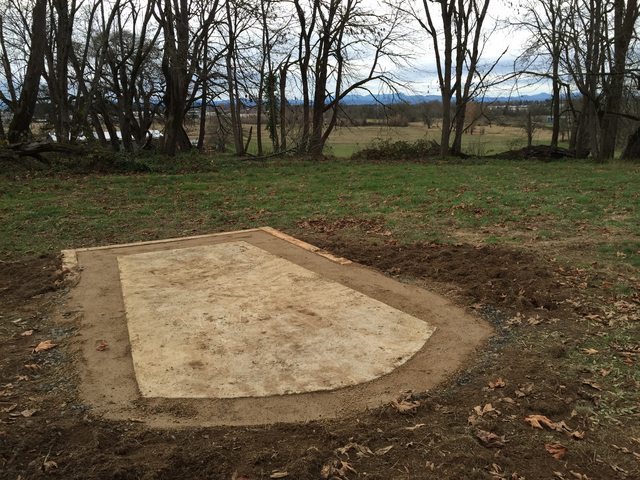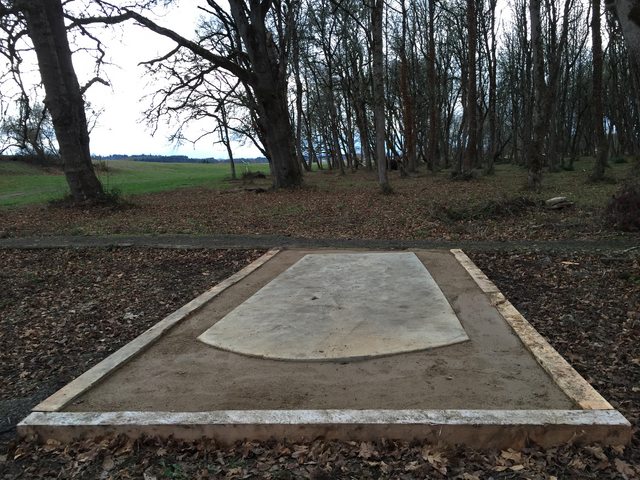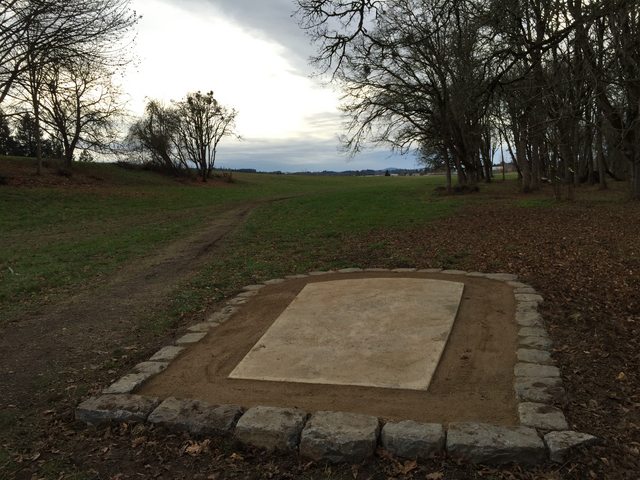Yeah makes sense. Just considering how other stances are taken it seems a bit weird. What happens when there are no tee edges really defined just a ending? Grass vs concrete or when players opt to tee off from dirt next to a rubber pad..?
-
Discover new ways to elevate your game with the updated DGCourseReview app!
It's entirely free and enhanced with features shaped by user feedback to ensure your best experience on the course. (App Store or Google Play)
You are using an out of date browser. It may not display this or other websites correctly.
You should upgrade or use an alternative browser.
You should upgrade or use an alternative browser.
Trapezoidal tee pads in backwards.
- Thread starter air show
- Start date
Yeah makes sense. Just considering how other stances are taken it seems a bit weird. What happens when there are no tee edges really defined just a ending? Grass vs concrete or when players opt to tee off from dirt next to a rubber pad..?
http://www.pdga.com/rules/official-rules-disc-golf/800-introduction/80002-definitions
Tee Line
The line at the front of the teeing area, or the line between the outside edges of two tee markers.
Teeing Area (or Tee)
The area bounded by the edges of a tee pad, if provided. Otherwise, the area extending three meters perpendicularly behind the designated tee line. The teeing area is also a lie.
Players can't opt to throw from next to or behind a rubber pad unless that option is provided by the TD.
Eternal_Noob
Newbie
My local course here, Morley Field, Tee pad #1 is like this. Short end at the back, wide at the front, but that's because they change the pins around every Monday and there is a pretty good gap, maybe 150 - 200 ft from the left pin to the right? and since the holes are maybe 250 ft away it's pretty dramatic from one side to the other on a regular tee pad, so I'm pretty sure it's reversed so that you can throw in either direction. Now that I think about it Hole 10 is like that too.
DamtheMan
Birdie Member
I've only seen rectangular pads here. Most of them are decent size ones too, only one of the courses, which rare for this area has pro and am tees, the am tees are tad too short for my liking (I've gotten used to making a decent run-up; that's what I've calibrated my timing to). Worse, one of the pads is elevated, so doing a run-up from behind it poses all sorts of problems.
knettles
Double Eagle Member
I'm sorry to whoever said there's a benefit to sloped teepads, but no. One, it can make runups much more difficult. Your lower body develops muscle memory for a runup, which you pretty much repeat exactly every drive. You just change the disc and angle of the throw with your arm. Teepads at different slopes make it a lot harder to repeat this motion consistently. And two, they pose an unnecessary danger. An upwards sloping pad can cause tripping on runup and a downward sloped pad can cause slipping (both of these followed by falling and injury in unlucky cases). If something can be done in disc golf to make it safer that doesn't hurt anything else, it's probably a good idea. Teepads should always be level, large enough for a standard runup (I've read 5' by 10'), and provide good traction. These factors improve the enjoyment and safety of the sport. The only reason to not follow these guidelines is simple ignorance. A lot of people just don't know. Now I'm done with my teepad rant. It's a touchy subject for me.



These are all wide in front, the pictures from behind the pad don't show the width at the front as well. 5' wide at back, 7.5' wide at front, 13.5' long at top of radial curve. Plenty of room for runups, and lots of space for different release points. Prefer the width at the front for sure.
I'm sorry to whoever said there's a benefit to sloped teepads, but no. One, it can make runups much more difficult. Your lower body develops muscle memory for a runup, which you pretty much repeat exactly every drive. You just change the disc and angle of the throw with your arm. Teepads at different slopes make it a lot harder to repeat this motion consistently. And two, they pose an unnecessary danger. An upwards sloping pad can cause tripping on runup and a downward sloped pad can cause slipping (both of these followed by falling and injury in unlucky cases). If something can be done in disc golf to make it safer that doesn't hurt anything else, it's probably a good idea. Teepads should always be level, large enough for a standard runup (I've read 5' by 10'), and provide good traction. These factors improve the enjoyment and safety of the sport. The only reason to not follow these guidelines is simple ignorance. A lot of people just don't know. Now I'm done with my teepad rant. It's a touchy subject for me.
You're not concerned about drainage?
PMantle
* Ace Member *
To be perfectly honest too much of course budget goes into giant teepads.
My biggest complaint about courses usually concerns the teepads. Hell, there are two courses I play regularly that I would donate to if the parks would commit to giant new pads.
knettles
Double Eagle Member
You're not concerned about drainage?
That's a good question. I'd say no. The only times I've seen stuff built up on top of teepads is when the tee was on a hill, and one end of the pad was flush with the uphill side of the ground. If barriers are built in properly, drainage isn't an issue. And yes, rain will still fall on the pad, but if the pad is truly flat and not concave, it still won't be an issue.
Also, if someone was incredibly worried about drainage, I would much prefer an ever so slightly convex pad as opposed to one that was slanted up or down. I'm talking where the edges are about half an inch lower than the center. An even curve where you wouldn't even notice.
it all depends on the player. watch lizotte play in some of the smaller tourneys. he throws these crazy lines around trees and obstacles. if you narrow the tee in the front, he wont be able to do things like that, however someone like jenkins or mcbeth who would rather play it safe and tread a needle, it might not affect them too much. not a right or wrong way but it cetainly can affect the way a player can see the hole
it all depends on the player. watch lizotte play in some of the smaller tourneys. he throws these crazy lines around trees and obstacles. if you narrow the tee in the front, he wont be able to do things like that, however someone like jenkins or mcbeth who would rather play it safe and tread a needle, it might not affect them too much. not a right or wrong way but it cetainly can affect the way a player can see the hole
LOL at the bolded.
As to your last point, it's a great one. Width, shape, and direction of the tee pad affects the way a player can see or throw the hole. That's the whole idea, isn't it? Designers create holes to challenge the players, not to give them "all the options". If the player can still find the "Lizotte" crazy lines, so be it, but he shouldn't necessarily be entitled to them.
- Joined
- Dec 19, 2009
- Messages
- 6,840
That's a good question. I'd say no. The only times I've seen stuff built up on top of teepads is when the tee was on a hill, and one end of the pad was flush with the uphill side of the ground. If barriers are built in properly, drainage isn't an issue. And yes, rain will still fall on the pad, but if the pad is truly flat and not concave, it still won't be an issue.
Also, if someone was incredibly worried about drainage, I would much prefer an ever so slightly convex pad as opposed to one that was slanted up or down. I'm talking where the edges are about half an inch lower than the center. An even curve where you wouldn't even notice.
If you lived in a place where the water becomes as hard as steel and builds up layer after layer for months, you would be incredibly worried about drainage.
Jesterian
Par Member
- Joined
- Feb 1, 2011
- Messages
- 192
LOL at the bolded.
As to your last point, it's a great one. Width, shape, and direction of the tee pad affects the way a player can see or throw the hole. That's the whole idea, isn't it? Designers create holes to challenge the players, not to give them "all the options". If the player can still find the "Lizotte" crazy lines, so be it, but he shouldn't necessarily be entitled to them.
You know, finesse players, like Avery Jenkins.
To be perfectly honest too much of course budget goes into giant teepads.
Doesn't that depend on the budget? Definitely not a complaint I have ever heard: "The teepads are too big and good".
MarkDSM
Double Eagle Member
Doesn't that depend on the budget? Definitely not a complaint I have ever heard: "The teepads are too big and good".
Ok, I have one sarcasm whine. Sometimes I only really need to clear half of a monster 12 footer of snow and ice for myself or it is a 230' short pin position. I feel obligated to clear the whole thing plus a couple feet behind the pad for stomping. More work!
Lewis
* Ace Member *
I prefer rectangular over trapezoidal, but if it has to be trapezoidal, I'd rather have the wide side at the front. I don't think there's a "wrong" shape, as long as it's wide and long enough, and fairly flush with the ground, so people don't break their ankles. The only bad shape is one that's too narrow or too short. I also hate it when the pads get installed at odd angles vs. the fairway. Nobody needs that game in their head. 
I think I finally figured this one out. "Wider in the front" people want it as wide as possible so they have more options. "Wider in the back" people want to be able to come in at an angle and still be on the pad as much as possible. So the answer to make everyone happy would be "as wide as possible in the front and flared out from there."
Is there anyone who wouldn't be satisfied with that?
Is there anyone who wouldn't be satisfied with that?
Similar threads
- Replies
- 15
- Views
- 2K
- Replies
- 33
- Views
- 3K
- Replies
- 41
- Views
- 4K
- Replies
- 30
- Views
- 3K